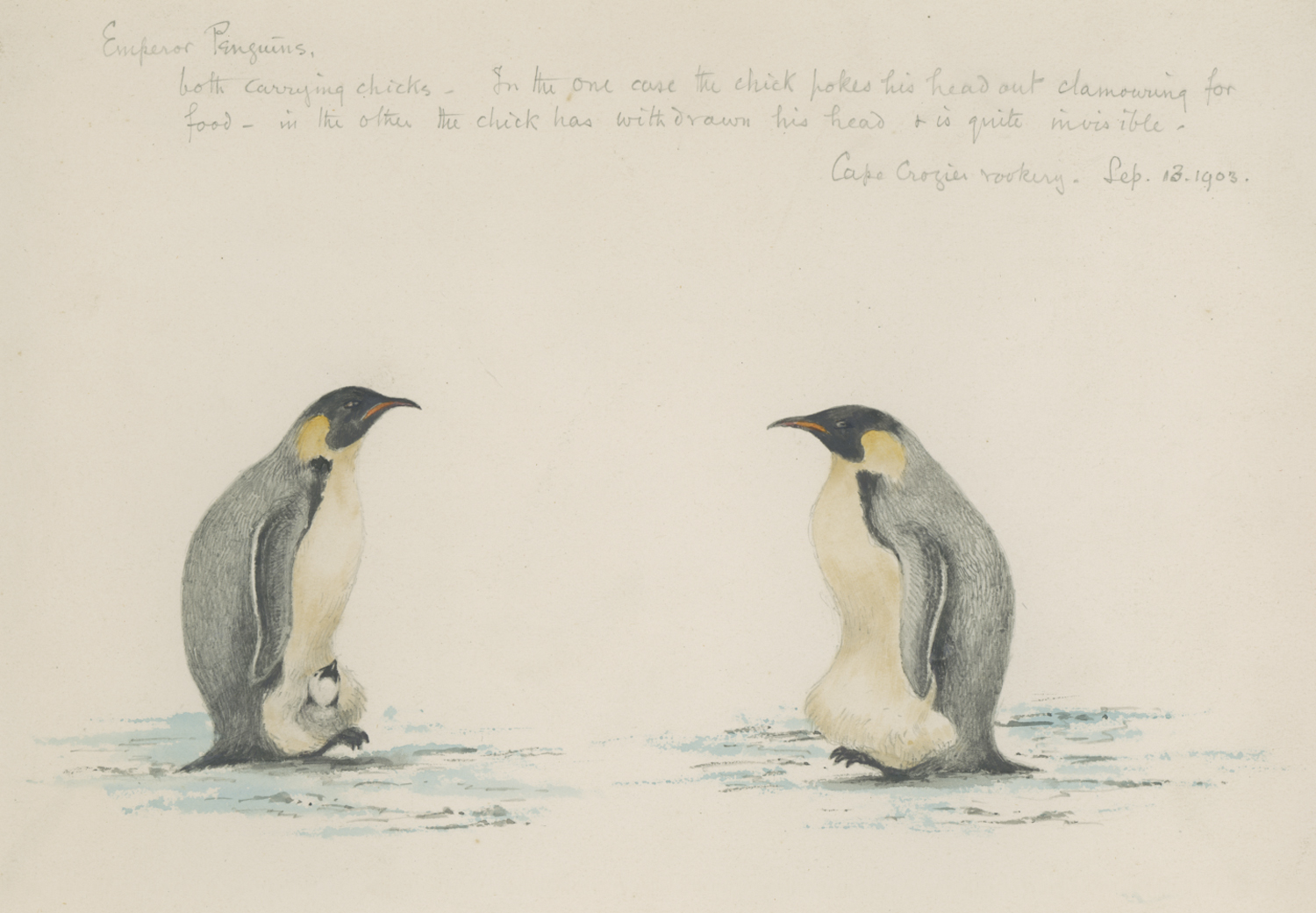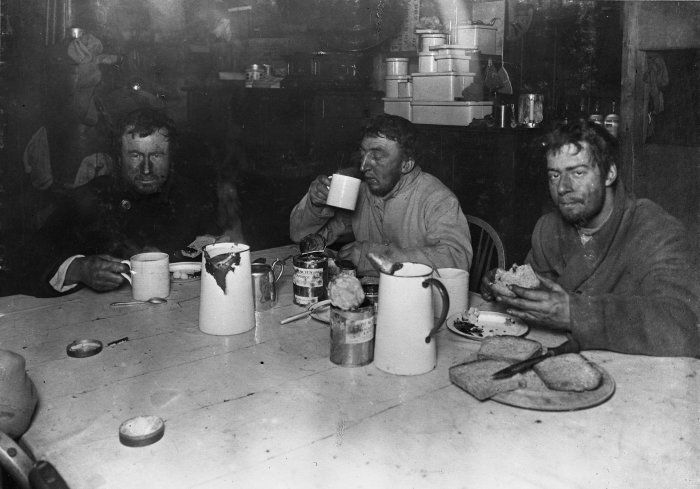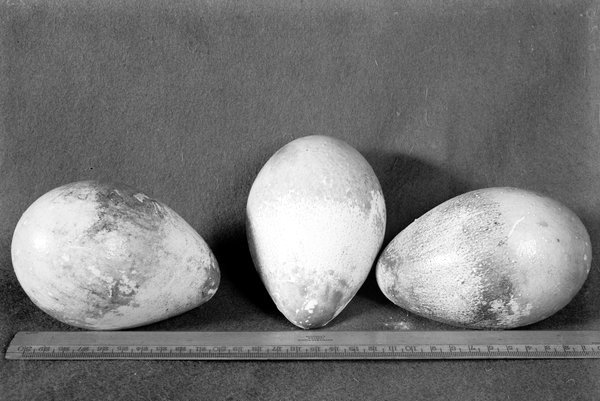Yesterday (12 November) marked the anniversary of the discovery, in 1912, of the remains of Robert Falcon Scott’s ill-fated Terra Nova Expedition to the South Pole. The story of that expedition’s side-trip to collect Emperor Penguin eggs is well-known, celebrated in myriad books, articles, documentary films and exhibitions. As is often the case with scientific exploration and discovery, there is a less-well-known backstory that raises some interesting questions about the more celebrated account.
Edward Adrian Wilson was the doctor, zoologist, and artist on Scott’s two famous Antarctic expeditions—Discovery in 1901-04 and Terra Nova in 1910-12. Wilson was a well-connected English artist and ornithologist, elected as a member of the BOU in 1900. Little surprise, then, that the prominent English ornithologist Percy Sclater [1] suggested to Wilson that he apply to be Junior Surgeon and Zoologist on Scott’s Discovery Expedition. On returning from that first expedition, Wilson worked as Field Observer for the Grouse Disease Commission in Scotland, but that’s a story for another day.

On the Discovery expedition, Wilson visited the Emperor Penguin colony at Cape Crozier where he made an extensive study of their breeding biology. In his published report of 1907, he mentions that:
The possibility that we have in the Emperor Penguin the nearest approach to a primitive form not only of a penguin but of a bird, makes the future working out of its embryology a matter of the greatest importance. It was a great disappointment to us that although we discovered their breeding ground. and although we were able to bring home a number of deserted eggs and chicks, we were not able to procure a series of early embryos by which alone the points of particular interest can be worked out…The whole work [of getting eggs for embryological study] no doubt would be full of difficulty, and it is with a view to whom the opportunity may occur in the future, that this outline has been added of the difficulties that would surely beset their path. [2]
Having provided all of the details needed to procure those precious embryos, Wilson was determined to get them during his second expedition to the Antarctica with Scott. But why were those embryos so important?
At the turn of the twentieth century, Ernst Haeckel’s Biogenic Law that ‘ontogeny recapitulates phylogeny’ was still very current. Wilson thus thought that an examination of the embryonic development of a bird thought to be very ‘primitive’ [3]—the Emperor Penguin—might shed some light on the origin of birds. Thus Wilson felt that the study of Emperor Penguin embryology might reveal some of the details about how birds evolved from reptiles, as had earlier been suggested by Sir Thomas Huxley and others. In the same volume as Wilson’s report from the Discovery expedition, William Plane Pycraft [4] wrote about penguin anatomy, based on specimens from the Discovery expedition. Pycraft laid the foundation for Wilson’s quest for the embryos when he speculated that:
All that can be gleaned from fossils, then, is that penguins have probably descended from birds which possessed full powers of flight, and this probability becomes converted into a certainty when the embryological evidence comes to be examined. But the question of the precise affinities of this group must still be regarded as an unsolved problem, the intense specialisation which these birds have undergone obliterating much of the necessary evidence. [5]
Wilson may also have thought that those embryos might answer the question about the origins of flightlessness on the penguins—had they evolved from flying birds, for example—by comparing their embryological development with that of other ‘primitive’ non-passerine birds like ducks.
In an 1887 paper, Mikhail Menzbier had also speculated that the extant birds might have evolved from two independent lineages leading from the reptiles, one to the flightless penguins and the other to the flying birds. We don’t know if Wilson even knew about that idea but a detailed study of the penguin’s embryology might have helped to resolve that issue as well.

During the Terra Nova expedition, Wilson’s fellow explorers found him to be very companionable and someone they could confide in—they called him ‘Uncle Bill’. Near the start of that expedition, in July 1911, Wilson, Henry Robertson “Birdie” Bowers [6] and Apsley Cherry-Garrard and made a horrendous winter trek—95 km each way, in the dark with extreme cold—from Cape Evans to the Cape Crozier colony where they obtained five incubated eggs that Wilson thought could be used for embryological study. Though Wilson and Bowers died with Scott and two others, Cherry-Garrard returned three of those eggs [7] to England where they were later dissected by three different embryologists over the next 20 years. One of those embryologists concluded—contrary to Wilson’s hopes—that those eggs: have not contributed much to the understanding of the embryology of penguins.

Strangely enough, the question that Wilson hoped to answer by obtaining those embryos had already been answered by the dissection of Gentoo and Adélie Penguin eggs collected by Robert Neal Rudmose-Brown [8] and James Hunter Harvey Pirie [9] on the Scottish National Antarctic Expedition of 1902-04 . The embryos in those eggs were studied by anatomists David Waterston and Auckland Campbell Geddes at Edinburgh University who concluded, in October 1909, that:
With regard to these developmental facts the question arises:— Is the duck’s or the penguin’s wing the more direct descendant of the common ancestor; or have they both diverged from the common stock approximately equally, but in opposite directions?
Embryology alone cannot answer this question, but the evidence is clear in this, that the fore limb of the penguin in its development goes through a progressive and continuous series of stages along one unbroken line…So that the answer to our question, so far as the embryological evidence is concerned, must be that the wings of both these birds are different from the ancestral wing, and that the differentiation has been in opposite directions and that the common ancestor was a flying bird of a somewhat primitive type depending in large measure for the spread of its wing upon bone and muscle. [10]
How did Wilson not know about this work, published in the Transactions of the Royal Society of Edinburgh, more than 8 months before the Terra Nova expedition began? Quite possibly he was too busy with his grouse research and illustration commissions to follow the recent publications, though that seems highly unusual given the intense interest in Antarctic exploration in general and penguins in particular in the early 1900s. Possibly, even if he knew about it, he might have felt that the work on Adélie and Gentoo Penguins could not actually answer the question because he may have felt that those species were not primitive enough. The Emperor is the only penguin that breeds in the Antarctic winter, and there was a notion, in those days, that this indicated that it was the most primitive bird.
Whatever the motives behind Wilson’s quest for Emperor Penguin eggs, his studies of their breeding biology is an outstanding early example of research into the breeding cycle, parental care, and offspring development of any bird.
SOURCES
- Cherry-Garrard A (1922) The Worst Journey in the World. London: Chatto and Windus
- Haeckel E (1866) Generelle morphologie der organismen [General Morphology of the Organisms]. Berlin: G. Reimer. http://www.biodiversitylibrary.org/item/22319#page/11/mode/1up (Accessed December 3, 2013).
- Menzbier M (1887) Vergleichende osteologie der pinguine in anwendung zur haupteintheilung der vogel. Bulletin de la Société impériale des naturalistes de Moscou 1: 483-587
- Mossman RC, Pirie JHH, Rudmose-Brown RN (1906) The voyage of the Scotia, being a record of a voyage of exploration in the Antarctic Seas. London: C. Hurst
- Peaker M (2014) In Search of a Penguin’s Egg. Why? Zoology Jottings blog posts on 8 April and 6 June 2014. retrieved online on 12 Nov 2017 at https://zoologyweblog.blogspot.ca/2014/04/in-search-of-penguins-egg.html and https://zoologyweblog.blogspot.ca/2014/06/in-search-of-penguins-egg-whycontinued.html
- Pycraft WP (1907) On some points in the anatomy of the Emperor and Adélie penguins. Section III pp 1-28 in Bell FJ, Fletcher L (eds) National Antarctic Expedition 1901-1904. Natural History Volume II. Zoology (Vertbrata : Mollusca : Crustacea). London: British Museum (Natural History) [available here]
- Waterston D, Geddes A (1910). X.—Report upon the Anatomy and Embryology of the Penguins collected by the Scottish National Antarctic Expedition, comprising: (1) Some Features in the Anatomy of the Penguin; (2) The Embryology of the Penguin: A Study in Embryonic Regression and Progression. Transactions of the Royal Society of Edinburgh 47: 223-244
- Seaver, G (1933) Edward Wilson of the Antarctic. Naturalist and Friend. London: John Murray
- Wilson EA (1907) Aves. Section II pp 1-121 in Bell FJ, Fletcher L (eds) National Antarctic Expedition 1901-1904. Natural History Volume II. Zoology (Vertbrata : Mollusca : Crustacea). London: British Museum (Natural History) [available here]
- Wilson EA (editor) (1908) National Antarctic Expedition 1901-1904. Album of Photographs and Sketches. London: Royal Society
Footnotes
- Sclater was of the founders of the BOU and the first editor of The Ibis
- quotation from Wilson 1907: 31
- we try not to use that term ‘primitive’ anymore when talking about species because it is really traits that might be ‘primitive’ (i.e, present in a common ancestor) or derived when comparing two species
- in 1907 Pycraft was on the staff of the British Museum (Natural History)
- quotation from Pycraft (1907)
- he was called “Birdie” by his fellow expeditioners not because he had any interest in birds, but because he looked a bit like a bird with his red hair and beak of a nose
- two of the eggs broke when the trekkers climbed a cliff to begin their journey back to Cape Crozier
- Rudmose-Brown wasa botanist who was appointed lecturer in geography at the University of Sheffield in 1907
- Pirie was a bacteriologist and medical doctor
- quotation from Waterston and Geddes (1910); later reproduced as pp 37-58 in Volume IV of Report on the scientific results of the voyage of S.Y. “Scotia” during the years 1902, 1903 and 1904, under the leadership of William S. Bruce, published in 1915 [available here]
IAMGES: all images are in the public domain, available from Wikimedia Commons
A fascinating story. Cherry-Garrard’s account of the expedition (The Worst Journey in the World, cited above), is gripping. The hardships those men encountered are unimaginable.
Bob,
Yes, the Cherry-Garrard story is certainly a remarkable one. The idea of being able to reconstruct the evolutionary history of birds by studying the most primitive was not new, something you point out. In a way, the challenge presented by trying to document ontogeny had lots going for it, especially in those days. Regardless of the scientific convolutions involved, it was a good idea at the time. Nevertheless, I still get chills thinking about the “Worst journey…”
Cheers,
Alan
Everyone should read Cherry-Garrard’s book (and also Dan Simmons’s ‘The Terror’ a mix of fantasy with historical fact and fiction) if you really want to know what it’s like to be cold. Cherry-Garrard apparently broke all his teeth from chattering on that expedition. There is more to the Cherry-Garrard story, I am told, and I am will see if I can get someone who knows the back story to write about it on this blog. Stephen Jay Gould wrote a pretty good book—Ontogeny and Phylogeny—about the value (and folly) of Haeckel’s notions about recapitulation.